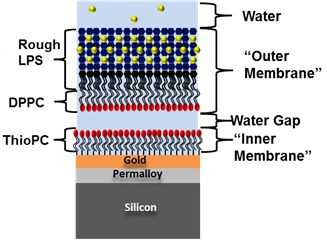This synthetic model will serve as a robust system and important tool in drug design, particularly in the development of antibiotics. The work, supported by the Wellcome Trust, was recently published as a ‘Hot Paper’ in the journal Angewandte Chemie International Edition.
Single celled gram-negative bacteria, such as E. coli, are a major cause of antibiotic-resistant infections, partly due to a highly impermeable, asymmetric outer membrane. Most antibiotics have to penetrate the inside of a bacterium to work, and gram-negative bacteria use their outer membrane to resist this. Although its chemical composition is well known, the structure and dynamics of this outer membrane are poorly understood since the structure is difficult to recreate or study in vitro.
“We have built, for the first time, a working bacterial membrane” says project leader Professor Jeremy Lakey, Newcastle University. “Now we can find out how the membrane works and design drugs to cross it.”
Most biological membranes are lipid bilayers with partial asymmetry in lipid content between the two layers. In contrast, the outer membrane has a highly asymmetric structure, creating this uniquely impermeable layer (Fig. 1).
The model was constructed at the ISIS facility in Oxfordshire and is 1/10,000th the thickness of a sheet of A4 paper. It consists of an asymmetric floating supported bilayer, which represents the outer membrane, supported on a layer of water which covers a monolayer of phospholipid on a smooth gold surface (Fig. 2). This gold layer is chemically bound to a silicon substrate through a thin layer of a magnetic alloy. The floating supported bilayer was created using Langmuir-Blodgett and Langmuir-Schaefer methods to compress and stack monolayers of molecules horizontally and vertically.

Figure 2. Structure of the complete outer membrane model.
The structure and asymmetry of the model was confirmed at the ISIS facility using neutron scattering and isotopic labelling studies. Neutron reflectivity experiments on the POLREF reflectometer at ISIS revealed the thickness, density and chemical composition of the layers of the model, and the scientists were able to build mathematical models to describe the multi-layered system. To reveal the precise location of the different components, the content of deuterium in the system was altered using deuterated molecules and solvents. Substitution of hydrogen atoms with deuterium (which scatters neutrons differently) resulted in a definitive description of where the individual molecular species were within the model.
“Neutron scattering allows us to resolve complex structures composed of mixtures of biomolecules,” says lead author and ISIS scientist, Dr Luke Clifton. “Using isotopic labelling, we were able to determine the relative positions of the different components in the model.”
Clifton and co-workers went on to test the response of the model to antimicrobial proteins, including lysozyme and lactoferrin. Interactions of these proteins with the outer membrane in vivo and in vitro are well known, allowing for direct comparisons with the synthetic model. Neutron reflectivity revealed that the experiments reproduced in vivo behaviour, replicating the disruption of the outer membrane, as seen in living bacteria.
“The bacterial envelope is very difficult to study largely because it is so small,” says Lakey. “This new model can now be used as a simulator to test our understanding of how it works and predict how new antibiotics will cross the barrier.”
The successful formation of this synthetic model which recreates the properties of the bacterial envelope will allow for a deeper understanding of this barrier to antibiotic function, and prove invaluable in future developments in antibacterial chemotherapy.
Preeti Kaur and Ellie Welch
Further Information
The research paper, published in Angewandte Chemie International Edition,can be found here.
Clifton, L. et al. (2015), An Accurate In Vitro Model of the E. coli Envelope, Angewandte Chemie, 54(41), pp. 11952-11955.
DOI: 10.1002/anie.201504287.
